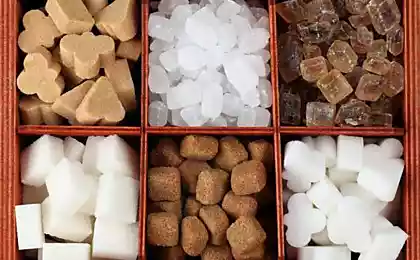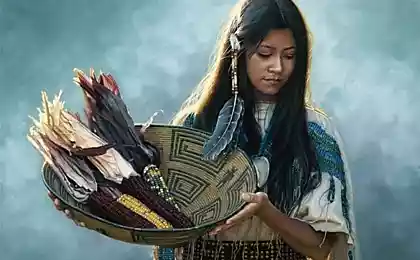1161
Sugar: white or sweet killer medicine?

Harmful or helpful this product - a question to which there is still no exact answer
Doctors vying blame the sugar in various ailments burdening our civilization. In a long list, and tooth decay and obesity, and diabetes, and allergies, and hyperactivity, and hypertension ...
But once an ordinary sugar was considered a rare medicine, it was hung in grams and sold only in pharmacies. To this day, a sweet powder continues to faithfully serve the medicine.
Indian delicacy and Napoleon
Products with intensive sweet taste usually contain glucose. This substance can be called "gasoline for the body" - it is absorbed most quickly, stimulating the vital functions, brain activity, banishing fatigue and mood lifting. But excess sugar harms the body, forcing the pancreas to secrete too much insulin to its processing. But the lack or absence of sugar in the diet food is not harmful - carbohydrates can be obtained from fruits, vegetables, cereals. But precisely because sugar causes euphoria and a burst of energy, people from ancient times been a sweet tooth. What just not to invent, to eat - digested and concentrated fruit juice, eating honey and dried fruit. American Indians have long been able to do analogue of sugar from the collected and condensed maple sap, and they were engaged in collecting only fed the years not to waste precious time on pampering.
Where, how, and who exactly invented the sugar, there is no exact information. However, it is known that spread through Europe, he started from Greece, after the campaigns of Alexander the Great - great conqueror in India offered to try amazing sweetener "Saqqara." King is so pleased that he took with him a treat, treated subjects - and soon learned about the sugar world.
Initially, the sugar made from sugar cane. They were brown lumps of irregular shape, with a taste of caramel. They cost almost no weight in gold - afford sweet tea or coffee could only very noble and rich person. Mongol khans were treated to slices of sugar dignitaries Arabs - harem of beauties and ungrateful girl using precious delicacy ... for hair removal!
Production and processing of sugar cane developed so slowly that at the beginning of the XVIII century, when Peter I permitted the importation of exotic goods for the year in Russia received a little less than a ton of sugar. But soon the slave trade and slave labor helped create the huge sugar cane plantations in the Caribbean, the market began to be filled with goods, sweets have become available not only crowned heads, but also the middle class. As a result of the Napoleonic Wars of sugar has virtually ceased, and France left "without sweet", the emperor was able to find an alternative outlet for citizens - he remembered Pat Marggraf German chemist who discovered how to chemically extract the sweet juice of ordinary beet. Napoleon ordered to equip the plants, gave subsidies on production and by 1830 the monopoly of the Caribbean came to an end. By the beginning of the XX century, this product has become so cheap that even prosperous peasants in Russia could afford to drink tea with sugar, a bit of sugar. Today, according to doctors, the production of sugar is high time to cut.
Sweetness guard health
Greek doctors first to appreciate the magical properties of sugar and began to use them. Firstly, as an independent cure for melancholy, loss of strength and headaches. Secondly, as a universal basis for the manufacture of pills and potions. Sugar has a huge hygroscopic, it absorbs large amounts of fluid, and the sweetness helps to mask the unpleasant taste of the drug. Sugar was a analgesic formulations that strengthen and cardiac drugs, is still used in the manufacture of syrups and tablets (for example, a tablet of vitamin C). In medieval pharmacies sugar weighed on special scales and sold by grams.
Sugar is widely used in homeopathy - tiny dose of the active ingredient mixed with sweet and formed the basis of round granules. The cosmetic industry, for example harem houris. It uses sugar for face masks, scrubs and hair removal, including in the most remote places. Traditional medicine uses sugar in many popular recipes. For example, a spoonful of sugar is ingested with the hiccups, juice, sprinkle with sugar using cold radish, turnip juice with sugar - with nosebleeds and bandage for sprains of grated and mixed with sugar, half the bulbs.
The most curious sweet pills sold in the United States. The drug «obecalp» (read the name of the other way around!), Containing sugar and fruit flavors, pediatricians prescribed to children with vague complaints that the survey did not reveal. And the placebo effect is often capricious little help to cope with the non-existent disease.
We will save the new antibiotic?
Recent discoveries of scientists have suggested: white sugar soon the enemy will become an irreplaceable friend sweet people. In English, the hospital with the help of a few kilograms of sugar was able to save the leg of 65-year-old patient with blood circulation in the lower extremities and an open wound. On the recommendation of the physician, worked for many years in Africa, fill with sugar and wound dressings changed every few hours. The patient was discharged from the hospital in perfect health. The reason for this miraculous recovery elementary - as already stated above, sugar is very hygroscopic. It cleans the wound, pulling them from the pus, and denies the possibility of spreading germs, literally draining them. Just a sweet therapy underwent hospital for 35 people, most actively on the mend. At a time when antibiotics are rapidly losing strength, a method of treating wounds will appeal to many.
Another brilliant idea of using sugar came up American pediatricians. We all know that children need to eat a lot of vegetables - fried, boiled, steamed or baked, but it is best with fresh. Everyone also knows that the boys and girls from the plant-based diet is not enthusiastic, preferring succulent burgers. But if you sprinkle broccoli or spinach special spray containing sugar, bitter leaves, and the children immediately begin to "clean" plates. Experiments have proved the success of this method. But doctors recommend not to abuse them, and as soon as the child gets used to the unfamiliar taste to refuse artificial improvers appetite.























